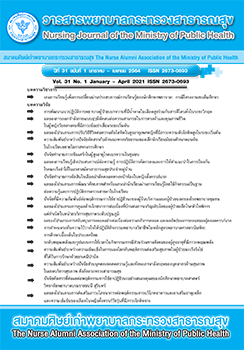Factors Influencing Decision-Making for Cesarean Section among Primigravidae
Main Article Content
Abstract
This descriptive study aimed to explore the influencing factors on decision-making for cesarean section among primigravidae. The sample consisted of 325 primigravidae who visited antenatal clinics at Hatyai Hospital and Songkhla Hospital from January to April 2019. They were recruited with a purposive clustering method. The research instruments for data collection comprised 6 sets of questionnaires to obtain information on 1)demographic characteristics, 2)fear of childbirth, 3) attitudes toward giving birth, 4)social support from health care providers, 5) perception of the risks of cesarean section, and 6) decision-making for cesarean section. Data were analyzed using descriptive statistics and logistic regression. The results of this study showed three predictive variables significant in the final model, including fear of childbirth, attitude toward birth and perception of the risks of cesarean section, and could explain the decision-making for cesarean section among primigravidae with statistical significance and prediction of 48% (Nagelkerke R2=.48, p<.05), and the final model correctly clarified 78.50% (overall percentage=78.50). Therefore, nurses should provide essential information to reduce fear of childbirth, encourage pregnant women to have positive attitudes toward giving natural birth, and promote the correct comprehensive content of the risk of cesarean section in order to reduce the cesarean section rate among primigravidae.
Article Details
บทความและรายงานวิจัยในวารสารพยาบาลกระทรวงสาธารณสุข เป็นความคิดเห็นของ ผู้เขียน มิใช่ของคณะผู้จัดทำ และมิใช่ความรับผิดชอบของสมาคมศิษย์เก่าพยาบาลกระทรวงสาธารณสุข ซึ่งสามารถนำไปอ้างอิงได้
References
2. Opiyo N, Oladapo OT, Souza J, Vogel JP, Bonet M, Kingdon C, et al. Non-clinical intervention to reduce unnecessary caesarean section. Bulletin of the World Health Organization [internet]. 2020 [cite 2020 Aug 15]; 98:66-8. Available from: https://www.who.int/bulletin/volumes/98/1/19-236729.pdf.
3. Yukaew N. Cesarean section rate according to Robson’s classification. Journal of Preventive Medicine Association of Thailand 2017;7(3):262-71. (in Thai)
4. Jantaburee N, Phumonsakul S, Theerakulchai J. Relationships between selected factors and maternal-infant attachment of unplanned cesarean section mothers. Journal of the Police Nurse 2019;11(2):387-95. (in Thai)
5. Sindecharuk T, Sakdabunyadecha S, Kobkitphaisansuk K. Cesarean section: which delivery should we really choose [internet]. 2014 [cited 2014 Nov 16]. Available from: http://doc.qa.tu.ac.th/documente/8.soc_ant/soc_ant/academic_year_2556.pdf.
6. Cunningham FG, Leveno KJ, Bloom SL, Spong CY, Dashe JS, Hoffman BL, et al. Williams obstetrics. 25th ed. New York: McGraw-Hill Education; 2018.
7. Choobmasjedi SG, Hasani J, Khorsandi M, Ghobadzadeh M. Cognitive factors related to childbirth and their effect on women’s delivery preference: a comparison between a private and public hospital in Tehran. Eastern Mediterranean Health Journal 2012;18(11):1127-32.
8. Banafsheh TN, Houshang J, Mahsa S. The reasons for choosing cesarean section as the delivery method by the pregnant women in the southwest of Iran. Journal of Medical and Dental Sciences 2014;2(2):108-11.
9. Phudanngua B. The Relationships among knowledge attitude and the social support for decision making to cesarean section of primigravida. Journal of Nursing and Health Care 2015;33(2):23-31. (in Thai)
10. Onbannasilpa S. Attitude toward cesarean section among primigravids at Krathum Bean hospital, Samut Sakhon province. Journal of Health & Science 2008;17(5):834-44. (in Thai).
11. Eide KT, Morken N, Baeroe K. Maternal reasons for requesting planned cesarean section in Norway: a qualitative study. BioMed Central Pregnancy and Childbirth 2019;19(102):1-10.
12. Kordi M, Bakhshi M, Masoudi S, Esmaily H. Effect of a childbirth psychoeducation program on the level of fear of childbirth in primigravid women. Evidence Based Care Journal 2017;7(3):26-34.
13. Chaweewan Y. Decision making regarding cesarean section among Thai pregnant women [Doctor of philosophy]. Chiangmai: Chiangmai University;2003.
14. Panyoi R, Phumdoung S, Thitimapong B. Fear of childbirth and coping strategies of adolescent pregnant women. Journal of Nursing Science & Health 2015;38(4):34-43. (in Thai)
15. Prabdin J, Phumdoung S, Thitimapong B. Fear of childbirth among prenant teenagers in the third trimester and its related factors. Journal of Nursing Science & Health 2017;40(2):96-106. (in Thai)
16. Piralrat P. Factors affecting elective cesarean section among nulliparous women [Master thesis]. Bangkok: Mahidol University;2002. (in Thai).
17. Jaisiri P. Social support affecting cervical cancer screening service on women in Ummao subdistrict Yangtalad district Kalasin province [Master thesis]. Chonburi: Burapha University;2010 (in Thai)
18. Kittisakchai T, Sansiriphun N, Kantaruksa K. Fear of childbirth in pregnant women and relates factors. Nursing Journal 2013;40(supplement):12-21. (in Thai)
19. Tara DC, Habi D, Alona H, Colleen H, Toni M. Elective cesarean section: Why women choose it and what nurse need to know. Nursing for Women’s Health 2009;12(6):480-8.
20. Srisatidnarakul B. The methodology in nursing research. 5th ed. Bangkok: U&I Inter Media;2010. (in Thai)
21. Kaewya P, Fhuapayom S. Fear of childbirth among adolescent postpartum mothers, and Related Factors [Master thesis]. Chiangmai: Chiangmai University;2018. (in Thai)

